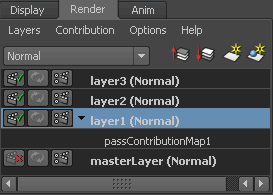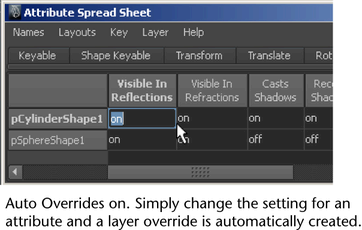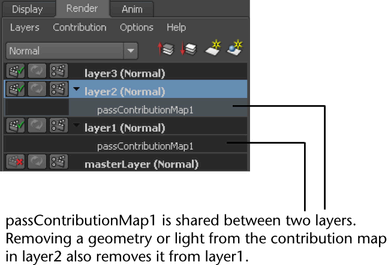From the Render Layer Editor, you can create, manage, and delete layers, layer blends, and layer overrides. You can also create render pass contribution maps for your render layers. A render pass contribution map is a subset of the objects in your render layer that you can create render passes for.
The multi-render pass feature is supported for the mental ray renderer. The rendering API allows other 3rd party renderers and custom renderers to support it moving forward.
You can open the Render Layer Editor in a separate window or view it in the same docked area as the Channel Box. To open the Render Layer Editor in a new window, select Layers > Floating Window.

The general workflow for using the Render Layer Editor is as follows:
Render layers are ordered based on their compositing order. The bottom of the list are the background elements, and the top of the list are the front most elements. The render layer compositing order can only be edited from the Render Layer Editor.
Use the up  and down buttons
and down buttons  to move render layers up and down. The buttons are only active if a single render layer is selected. You can also use the
middle mouse button to drag the layers up and down.
to move render layers up and down. The buttons are only active if a single render layer is selected. You can also use the
middle mouse button to drag the layers up and down.
Follow these guidelines to perform per layer overrides:
 between red and green to re-render the layer or to recycle the previously rendered image. To reuse the last rendered image
for this layer, toggle this icon to green
between red and green to re-render the layer or to recycle the previously rendered image. To reuse the last rendered image
for this layer, toggle this icon to green  . To re-render the selected layer, toggle this icon to red
. To re-render the selected layer, toggle this icon to red  .
.
 (controls) to display render settings (including which renderer is selected) for that layer. If there’s a renderer override,
this icon becomes an active controls icon.
(controls) to display render settings (including which renderer is selected) for that layer. If there’s a renderer override,
this icon becomes an active controls icon.
 ), you can further select whether to show the composite image, the composite image and the individual rendered layers, or
just the individual rendered layers.
), you can further select whether to show the composite image, the composite image and the individual rendered layers, or
just the individual rendered layers.
 icon next to each layer to set whether a layer is renderable or not.
icon next to each layer to set whether a layer is renderable or not.
You can create render pass contribution maps for each render layer. For example, if your render layer consists of 5 objects and 2 lights, you can create a diffuse pass, an ambient pass, and a specular pass for only 3 of the objects and 1 of the lights. To do so, create a pass contribution map containing the 3 objects and the light that you would like to create your diffuse, ambient and specular pass for. You can create multiple pass contribution maps for each render layer. You can also share pass contribution maps between render layers.
Click the icon to expand or collapses the list of pass contribution maps associated with the selected layer. This icon appears after
you have associated a pass contribution map with the layer.
icon to expand or collapses the list of pass contribution maps associated with the selected layer. This icon appears after
you have associated a pass contribution map with the layer.
You can create your render pass contribution maps using this menu.
You can set the following binary options:
The Auto Overrides option simplifies the workflow for creating layer overrides for attributes such as Casts Shadows, Receive Shadows, and Visible in Reflections.
The Auto Overrides option is applicable to the following attributes:
When the Auto Overrides option is on, you can simply click on each of these attributes and an override will be created for the selected layer. Upon being unchecked, the attribute name immediately turns orange to indicate that a layer override has been created. This eliminates the need to right-click the attribute and select Create Layer Override.

If your scene contains a lot of surfaces, you can also use the Attribute Spread Sheet to create a layer override. As in the case of the Attribute Editor, when the Auto Overrides option is on, you can simply change the setting for each of the attributes and a layer override is automatically created.

This feature is most useful when there are multiple objects/layers in the scene for which overrides need to be created. This feature simplifies the workflow by eliminating the need to select Create Layer Override.
When using namespaces, object names can sometimes get very long. This can make it difficult to differentiate objects by name. Turning off the display of namespaces replaces the namespace portion of a node’s name (if any) with “...:”. The shortened name makes it easier to distinguish between different objects in your scene.
Namespaces are the preferred method for managing naming when working with file references in Maya. It is not recommended that you employ Maya's renaming prefix convention when using file referencing. While the DAG path or long name of a node may make it unique when using renaming prefixes, they do not work consistently within file referencing and complicate the hierarchical DAG changes, which may cause problems later on.
Context-sensitive menu for render layers
The following commands are available when you right-click a layer:
Removes any render setting overrides for the current layer. For more information, see Work with layer overrides.
Removes any render flag (layer attributes) overrides for the current layer. For more information, see Work with layer overrides.
Removes the current material override for the select object(s) on the current layer. For more information, see Work with layer overrides.
Allows you to select a new material override for the current layer. For more information, see Work with layer overrides.
Allows you to select an existing material override for the current layer. For more information, see Work with layer overrides.
Context-sensitive menu for pass contribution maps
The following commands are available when you right-click a render pass contribution map.
Pass contribution maps can be shared between several render layers. In this case, removing a geometry or light from a pass contribution map in one layer also removes it from the same contribution map in the other layers. Therefore, you should exercise caution if you change the membership of a pass contribution map that is shared between layers. To avoid this problem, create separate pass contribution maps for each render layer.
